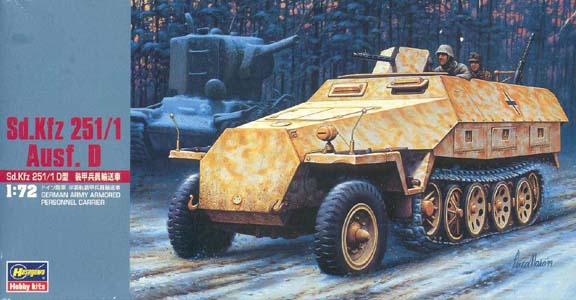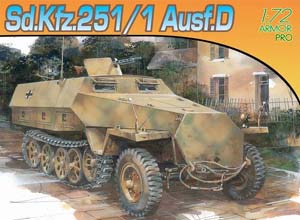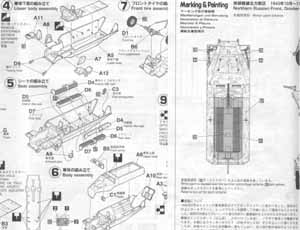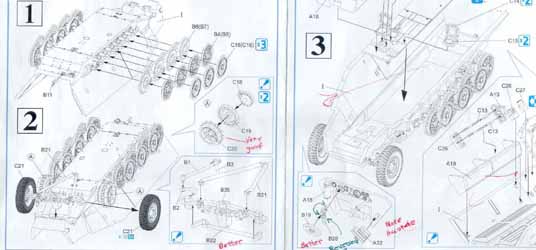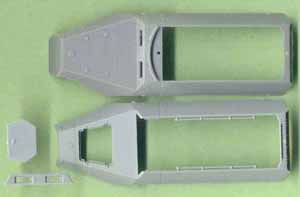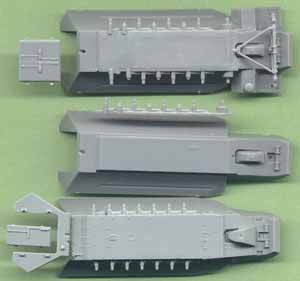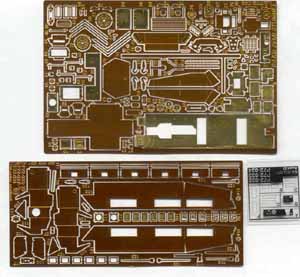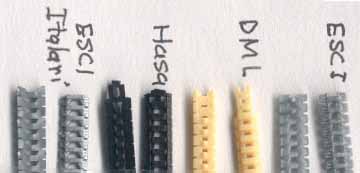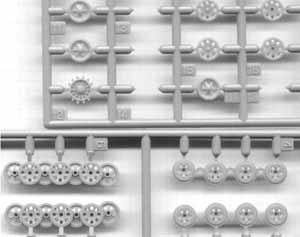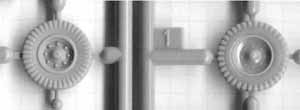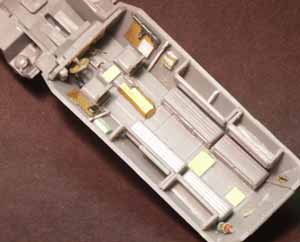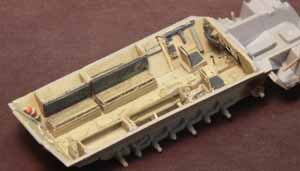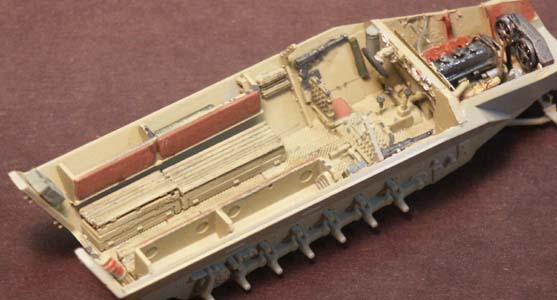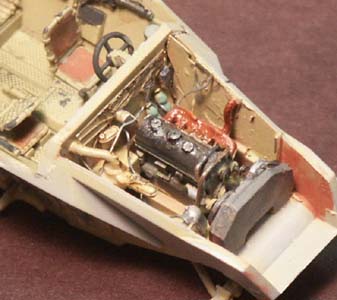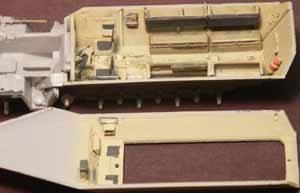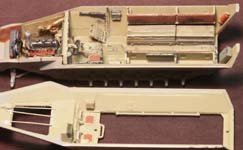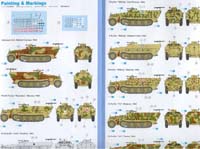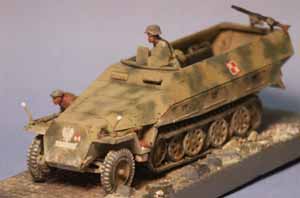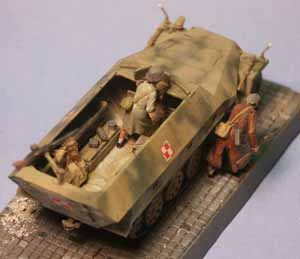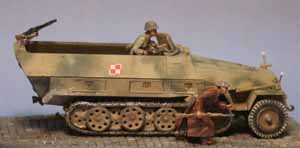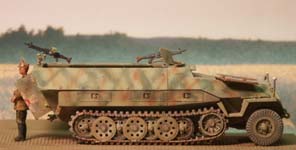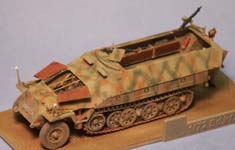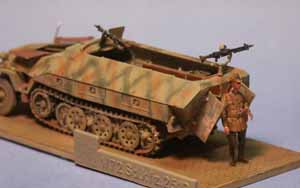Sd.Kfz.251
Ausf. D mittlerer Schützenpanzerwagen
I. Introduction This review covers two 1/72
scale German halftrack kits in 1/72 scale, the Sd.Kfz.251 Ausf.D
version from the Japanese firm Hasegawa, and from the Chinese firm
Dragon Models Limited [a.k.a. DML or just Dragon]. The Ausf.D, or
D model, was the final and most widely produced variant in 22 different
versions, from infantry carriers to engineer vehicles to self propelled
artillery. The D version differed in having a simplified hull compared
to the Ausf.C to allow an increased production when the war began
to go bad. There is so much information in books and on the web
that I will not go further into history and use during this review.
II. Assembly Instructions Both manufacturers give us the standard black and white, exploded-view type of assembly instructions with clear sprue and part numbers.
III. The Superstructure Parts At the top is the Hasegawa hull superstructure consisting of parts A6 and the front driver’s plate [B6] with open visors already glued in. Below Hasegawa's superstructure is the DML superstructure [part A1] in the slightly lighter gray styrene, also with separate front plate with open visors [part A18], and separate nose armor plate [part A13].
A separate driver’s roof [B16] and the engine compartment doors [parts A6 & A7] are not shown. [Note that the engine doors for Dragon’s Ausf D are not interchangeable with the doors for the Ausf C.] Both kits compare well in length and width. An obvious difference between the two manufacturers is the long crew compartment handles that DML molds into the top edge of their hull, and that DML offers an open engine compartment. Depending on the version DML instructs us to remove these handles. If so, save the handles for the Hasegawa or ESCI kits.
IV. The Suspension The Sd.Kfz.251 had interleaved roadwheels and rubber padded lubricated tracks common to most German halftracks of the time. In 1944 the Germans experimented and soon dropped the idea of steel padded tracks so as to save on scarce rubber. Both DML and Hasegawa have the correct 14 roadwheels; the rear roadwheel doubles as the idler wheel. Second from right are DML’s
cream colored soft band tracks. DML’s detail is very good
top and bottom, they have accurate guide teeth, and wrap around
the wheels and sag well and glue easily. They are narrower than
ESCI’s tracks [at the very left and right, for comparison].
At the top are Hasegawa’s wheels with the two-piece sprocket [part D12 & D14] (parts D14 have in this case been already cut off). The Sd.Kfz.251 had four rows of interleaved roadwheels. Note how the center wheels [parts 11 & 13 on the Hasegawa sprue, and parts 4 & 5 on the DML sprue] have six holes and spokes. The very inner and outer wheels [parts 15 & 16 etc. on the Hasegawa sprue and parts 6 on the DML sprue] have eight holes. Both DML and Dragon got their wheels correct. At right is Dragon’s front
wheel, common to all their 251 kits. Hasegawa’s wheel has
smaller bolt detail but larger tire tread. Both, I feel, are reasonable
reproductions.
V. The Interior Here is a view of Hasegawa’s
interior dressed up with a few PART brass pieces and spare parts
from Dragon’s 251 kits. Evident is some brass floor plates
to add some extra texture to the deck. PART actually offers a complete
new etched brass floor with nice tread texture in their 251 upgrade
frets for the Hasegawa kits. b) Dragon Dragon’s interior has more parts and more accurate details. Here we see the wooden bench seats in the rear, crew MP40 submachineguns, the upper hull fittings with handrails, and the ExtraTech engine in the front. The bench seats correctly match the references and can be set in raised or lowered position. The spring texture on the back of the driver’s seats, for example, is beautiful. The padded backrests are done as brown leather. There are big ejector pin marks on the inside of the bins (backrests) that cannot be seen after the upper superstructure [part A6] is glued on. DML includes the important flanges [parts C9] present on the interior where the driver’s area bolts to the rear crew compartment. This view is of Hasegawa’s
lower right side of the hull with the underside of the upper hull.
On the upper hull we can see the vehicle radio and interior sides
of the visors, made from etched brass in this case. Most of the
driver’s area features are not visible once the two hull sections
are assembled.
VI. Painting & Markings DML offers full color three view drawings for all their depicted vehicles, which is great. Many diagrams are of vehicles that appear based on single, rare black & white photos, so I would take the accuracy of the scheme and markings with skepticism. For example, many WW2 era vehicle photos show only two oblique sides at best, so knowing the markings and colors on all four sides is artist’s license. You do the best you can do, and who can prove you wrong? Except for Hasegawa’s color box art, their color & markings instructions are in black and white and are adequate. If you use Dragon’s color chart take note that they describe the base vehicle color H66/19 as RLM Sand Gelb 79 (a Luftwaffe color). From all my references I understand this should be Dunkelgelb nach Muster (later numbered RAL 7028) which is also a tan color. Dunkelgelb was used from February of 1943 till the war’s end in 1945. Sand Gelb RLM 79 was a darker and more tan color used in North Africa and the Sd.Kfz.251 Ausf.D was never used in Africa. As for the vehicle interior; prior to the February 1943 change, the interior of the Sd.Kfz.251 as well as the Sd.Kfz.250, was painted off-white in the forward driver’s area, and the exterior gray color aft of the flange holding the front to the rear. After the switch to Dunkelgelb [dark yellow] the driver’s area was the same panzer yellow as the rest of the vehicle. In the above Painting & Markings
guide note the smaller blue decal sheet for the halftrack license
plates. Note that rather than ready made license plates for each
suggested vehicle, they give us blank white plates and then separate
numbers and letters. Good luck getting the numbers on straight!
VII. Conclusions Both the Hasegawa and the DML kits build into satisfactory 1/72 scale Sd.Kfz.251 models. DML gives us more and more delicately molded parts; generally speaking this should make a better display model. A wargamer though may prefer the Hasegawa kit for its simplicity and quicker assembly.
VIII. References [1] PANZER TRACTS No 15-3 mittlerer Schuetzenpanzerwagen Ausf. C & D, By Thomas Jentz & Hilary Doyle. A superb softcover on the production, variants, organization and employment history of the Sd.Kfz.251 from 1943 to 1945, with scale drawings and sharp black & white photos. The Panzer Tracts books are probably the most accurate English language source for information on German WW2 vehicles. Highly recommended for the modeler and historian. [2] PANZER TRACTS No 15-2 mittlerer Schuetzenpanzerwagen Ausf. A to C, 1939 to 1942 , by Thomas Jentz & Hilary Doyle. This is a companion book to Panzer Tracts No. 15-3, and both books expand on and have replaced Panzer Tracts No. 15. [3] Hanomag Sd.Kfz 251 website http://www.geocities.com/MotorCity/Pit/3515/251/index.htm (currently off-line). The excellent website dedicated to the Sd.Kfz.251 halftrack, by Piet van Hees. [According to Jentz & Doyle, ‘Hanomag’ was never an official or slang term for the 251, but apparently is a post war term based on one of the many manufacturers of this vehicle.] [4] Sd.Kfz 251 In Action, Squadron/Signal Armor No. 21, by Charles Kliment & Don Greer (1981). An old book with some old disproved information, but inexpensive and containing great photos, color plates and sketches. Very recommended. [5] SCHUTZENPANZERWAGEN War Horse of the Panzer Grenadiers, by Horst Scheibert (1992), Schiffer Military History. An inexpensive softcover with period photos and coverage of the Sd.Kfz.251 and its smaller cousin the Sd.Kfz.250. |

